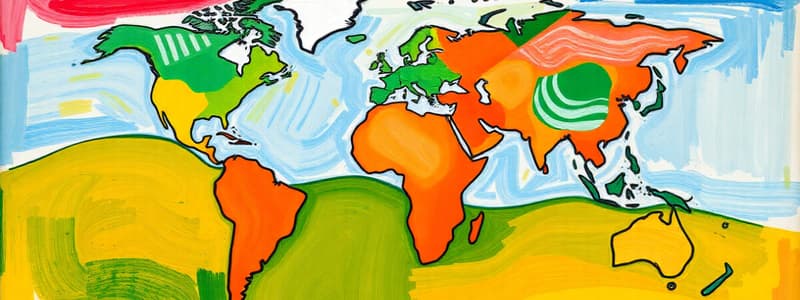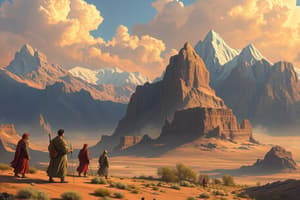Podcast
Questions and Answers
Which discipline primarily investigates the Earth's features and the interplay between natural processes and human societies in shaping it?
Which discipline primarily investigates the Earth's features and the interplay between natural processes and human societies in shaping it?
- Environmental Science
- Geology
- Geography (correct)
- Sociology
Who is credited with being the first to use the term 'geography' and is recognized as the 'Father of Geography'?
Who is credited with being the first to use the term 'geography' and is recognized as the 'Father of Geography'?
- Ptolemy
- Eratosthenes (correct)
- Strabo
- Herodotus
Anthropogeography, focusing on the influence of human culture and society on Earth's formation, is also known as which branch of geography?
Anthropogeography, focusing on the influence of human culture and society on Earth's formation, is also known as which branch of geography?
- Regional geography
- Physical geography
- Environmental geography
- Human geography (correct)
The study of natural events and their historical impact on shaping the Earth is primarily the focus of which branch of geography?
The study of natural events and their historical impact on shaping the Earth is primarily the focus of which branch of geography?
Around what time period did the study of Earth officially receive the name 'geography'?
Around what time period did the study of Earth officially receive the name 'geography'?
What was the primary purpose behind the development of the Five Themes of Geography in 1984?
What was the primary purpose behind the development of the Five Themes of Geography in 1984?
Which of the Five Themes of Geography deals with both the mathematical location using coordinates and the location of a place in relation to other places?
Which of the Five Themes of Geography deals with both the mathematical location using coordinates and the location of a place in relation to other places?
The theme of Human-Environment Interaction in geography is best described as the study of:
The theme of Human-Environment Interaction in geography is best described as the study of:
What is the key distinction between a physical boundary and a political boundary?
What is the key distinction between a physical boundary and a political boundary?
Which of the Five Themes of Geography involves dividing the Earth into areas for study based on shared characteristics, which can be formal, functional, or vernacular?
Which of the Five Themes of Geography involves dividing the Earth into areas for study based on shared characteristics, which can be formal, functional, or vernacular?
Which of the following best defines metageography?
Which of the following best defines metageography?
Which of the following is NOT considered a macrogeographic region?
Which of the following is NOT considered a macrogeographic region?
What is the primary function of a thematic map?
What is the primary function of a thematic map?
Which type of thematic map uses continuous lines to represent data such as changes in elevation?
Which type of thematic map uses continuous lines to represent data such as changes in elevation?
In a cartogram map, what does the distortion of geographical area typically represent?
In a cartogram map, what does the distortion of geographical area typically represent?
What is the defining characteristic of a functional region?
What is the defining characteristic of a functional region?
Which continent is unique for having no permanent human civilizations according to the text?
Which continent is unique for having no permanent human civilizations according to the text?
Eurasia is described as a combination of which two continents?
Eurasia is described as a combination of which two continents?
Which tool uses satellites to calculate the location of objects by measuring radio signal frequencies?
Which tool uses satellites to calculate the location of objects by measuring radio signal frequencies?
What is the first step recommended when locating a place on a world map, based on the provided text?
What is the first step recommended when locating a place on a world map, based on the provided text?
What is the primary distinction between a map key and a map legend?
What is the primary distinction between a map key and a map legend?
A map scale with a ratio of 1:25,000 indicates that:
A map scale with a ratio of 1:25,000 indicates that:
Which of the following pairs correctly identifies the components of the geographic coordinate system?
Which of the following pairs correctly identifies the components of the geographic coordinate system?
What is the reference line for measuring longitude?
What is the reference line for measuring longitude?
When converting latitude and longitude coordinates to plot on a Cartesian plane, latitude is typically assigned to which axis?
When converting latitude and longitude coordinates to plot on a Cartesian plane, latitude is typically assigned to which axis?
Contour lines on a topographic map are used to represent:
Contour lines on a topographic map are used to represent:
What is the primary purpose of a geologic map, beyond showing topography?
What is the primary purpose of a geologic map, beyond showing topography?
According to the definition provided, what is a key criterion for a celestial body to be classified as a planet?
According to the definition provided, what is a key criterion for a celestial body to be classified as a planet?
What is the fundamental difference between a meteoroid, a meteor, and a meteorite?
What is the fundamental difference between a meteoroid, a meteor, and a meteorite?
Which characteristic is common to terrestrial planets in our solar system?
Which characteristic is common to terrestrial planets in our solar system?
Flashcards
Physical Geography
Physical Geography
The study of the Earth's physical features, including landforms, climate, vegetation, and natural resources. It looks at how these features have been shaped over time by natural processes.
Human Geography
Human Geography
The branch of geography that examines the relationship between humans and their environment. It focuses on how human societies and cultures have modified and adapted to the Earth's landscapes.
Absolute Location
Absolute Location
The exact location of a place on Earth, often expressed using coordinates like latitude and longitude.
Relative Location
Relative Location
Signup and view all the flashcards
Region
Region
Signup and view all the flashcards
Political Boundaries
Political Boundaries
Signup and view all the flashcards
Physical Boundaries
Physical Boundaries
Signup and view all the flashcards
True Location vs. Perception
True Location vs. Perception
Signup and view all the flashcards
Metageography
Metageography
Signup and view all the flashcards
Macrogeographical regions
Macrogeographical regions
Signup and view all the flashcards
Thematic Maps
Thematic Maps
Signup and view all the flashcards
Cartograms
Cartograms
Signup and view all the flashcards
Choropleth Maps
Choropleth Maps
Signup and view all the flashcards
Graduated Symbol Maps
Graduated Symbol Maps
Signup and view all the flashcards
Isoline Maps
Isoline Maps
Signup and view all the flashcards
Dot Distribution Maps
Dot Distribution Maps
Signup and view all the flashcards
Flow-line Maps
Flow-line Maps
Signup and view all the flashcards
GPS (Global Positioning System)
GPS (Global Positioning System)
Signup and view all the flashcards
What is a map key?
What is a map key?
Signup and view all the flashcards
What is a map legend?
What is a map legend?
Signup and view all the flashcards
What is map scale?
What is map scale?
Signup and view all the flashcards
What is the geographic coordinate system?
What is the geographic coordinate system?
Signup and view all the flashcards
What is latitude?
What is latitude?
Signup and view all the flashcards
What is longitude?
What is longitude?
Signup and view all the flashcards
What is a Cartesian coordinate plane?
What is a Cartesian coordinate plane?
Signup and view all the flashcards
What are contour lines?
What are contour lines?
Signup and view all the flashcards
What is a topographic map?
What is a topographic map?
Signup and view all the flashcards
What is a geologic map?
What is a geologic map?
Signup and view all the flashcards
Study Notes
Geography Fundamentals
- Geography studies Earth's features and how humans and the environment interact.
- Eratosthenes is considered the "Father of Geography."
- Geography is divided into physical and human geography.
- Physical geography examines natural Earth processes.
- Human geography (also known as anthropogeography) explores human impact.
- Geography has a long history, dating back to 1500 BC.
Five Themes of Geography
- Developed in 1984 to simplify geographic study.
- Location: Absolute (exact) and relative (position to other places).
- Place: Physical and human characteristics.
- Human-Environment Interaction: How humans adapt and impact their surroundings.
- Movement: Human, goods, and information flow.
- Region: Formal, functional, and vernacular regions to divide Earth.
Macrogeographic Regions
- Five main macrogeographic regions: Oceania, The Americas, Africa, Asia, and Europe.
- Regions are large, encompassing smaller subregions and political entities.
- Macro regions are not static, locations are relative to our perception.
Metageography
- Metageography explores cultural views of geographic features (e.g., "East/West").
- Concepts of East and West are culturally influenced rather than purely geographical.
- Coined by Martin Lewis in 1997.
Geography as a Science
- Geography combines natural and social sciences, studying physical Earth and human phenomena.
- Provides tools like cartography that have evolved from ancient to modern formats (e.g., clay tablets to GPS and GIS).
- Cartography is the creation of maps, including thematic maps that show patterns and relationships in particular locations.
- GPS (Global Positioning System): Uses satellites for precise location determination.
- GIS (Geographic Information Systems): Integrates geographic data for analysis and communication.
Types of Thematic Maps
- Isoline map: Represents continuous data (e.g., elevation).
- Cartogram map: Distorts area based on data (e.g., population size).
- Choropleth map: Uses color/shade to indicate amounts (e.g., political affiliation).
- Graduated symbol map: Uses size to represent data (e.g., city size).
- Heat map: Represents density using shaded areas (e.g., weather map).
- Dot distribution map: Represents data using dots (e.g., disease incidence).
- Flow-line map: Shows flow and quantity using lines (e.g., goods shipment).
Geographic Regions
- Mapmakers divide the Earth into various regions.
- Regions can be administrative, based on shared characteristics (formal), reliant on a system (functional), perceived (vernacular).
- 7 major global regions (continents) including, North America, South America, Eurasia, Africa, Australia/Oceania, and Antarctica.
Locating Places on a Map
- Continents, countries, states/counties, and cities help find locations.
- Knowing the continent, country, state/county, and specific location helps narrow the search.
Components of a Map
- Maps represent an area symbolically..
- Maps show spatial relationships.
- Map Key/Legend: Explanatory elements, symbols, and colors.
- Map Scale: Ratio of map distance to real-world distance.
Geographic Coordinate System
- Locates points on a spherical Earth using latitude and longitude.
- Latitude: North/South position from the equator (0 degrees).
- Longitude: East/West position from the prime meridian (0 degrees).
- Values are in degrees, minutes, and seconds.
- Cartesian Coordinate Plane: Allows for plotting latitude/longitude on a flat plane. Decimal degrees can be used to plot onto a graph.
Geographical Coordinates
- Geographical coordinates are numerical values that define a position on Earth.
- Defines a point or location on Earth.
- Latitude: Measures degrees north or south of the equator.
- Longitude: Measures degrees east or west of the prime meridian.
- Geographical Coordinates System (GCS) defines how coordinates are expressed.
Maps and Scale
- Scale maps show ratios between map distance and real distance.
- Ratio (e.g., 1:50,000) indicates the relationship between map units and real units.
- Allows for measurement using any unit (inches, centimeters, etc.) to determine actual distance on the ground.
Topographic Maps
- Topographic maps show elevation using contour lines.
- Contour lines connect points of equal elevation.
- Index contours show exact elevations.
- Contour intervals represent elevation changes between lines.
- Contour lines never cross and form closed loops around features (hills and depressions).
- Hachures show depressions.
Geologic Maps
- Geologic maps combine topographic features and rock types/ages.
- Different types of rocks are represented by different colors.
- Map keys show rock types and color codes.
Earth's Solar System
-
Earth's solar system contains the sun, eight planets, and other celestial bodies.
-
Planet: Significant gravity, spherical shape, and clear orbital path around sun.
-
Moon: Orbits a planet.
-
Asteroid: Rocky or metallic body orbiting the sun.
-
Comet: Icy body orbiting the sun with a tail.
-
Meteoroid: Space rock.
-
Meteor: Meteoroid entering Earth's atmosphere and heating up.
-
Meteorite: Meteor that hits the Earth's surface.
-
Terrestrial Planets: Solid surfaces (Mercury, Venus, Earth, and Mars).
-
Jovian Planets (Gas Giants): No solid surfaces (Jupiter, Saturn, Uranus, and Neptune).
Studying That Suits You
Use AI to generate personalized quizzes and flashcards to suit your learning preferences.
Description
Explore the fundamental concepts of geography, including the key themes that shape our understanding of the world. This quiz covers physical and human geography, macrogeographic regions, and the five essential themes outlined in 1984. Test your knowledge and see how well you understand Earth's features and human interactions.




